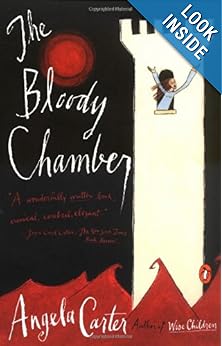
I grew up on fairy tales. My father made sure to raise his daughters feminist and read to us from two books of women-centric fairy tales: The Maid of the North and Tatterhood.
Fairy tales are never benign, never safe, no matter how much life has been sucked out of them. Even Disney, though it needs to tack happy endings onto its renditions, removing the knives that stab the little mermaid’s feet, letting her live, still has to give us Ursula, and steal Ariel’s voice.
And how much less safe the early versions were–the wolf calls Red Riding Hood a slut and eats her up, the stepmother feeds her husband his son in a stew, the girl has to cut off her own finger to free her brothers. When there is a happily ever after, it is hard earned.
A movement has risen in the past twenty years to bring back the old, dangerous fairy tales. Collections like Snow White, Blood Red edited by Ellen Datlow and Terri Windling in the early 1990s showcased the talents of fantasy writers who were starting to use fairy tale elements in their stories. (The genre of urban fantasy owes a lot to this movement.)
But before all of them, Angela Carter, in 1979, wrote The Bloody Chamber. In it she retells many fairy tales, some more than once. She keeps coming back to the wolf and the young girl, in the stories of Bluebeard, Little Red Riding Hood, Beauty and the Beast, and various werewolf tales. Sometimes the girl turns the tables, sometimes she escapes, and sometimes she dies.
Carter manages to update the stories while keeping their essential, timeless, fairy-tale-ness. The story “The Bloody Chamber” is her retelling of Bluebeard, and is set in a world with phones and trains, but is still removed from all those things, and feels archetypal. “The Bloody Chamber” dwells on the luxury and wealth of Bluebeard’s home with a fantastical, overwhelming accretion of detail, until the reader, even knowing what we do about the ending of Bluebeard, is seduced by him and his surroundings.
The well-chosen detail is one of the chief pleasures of all of Carter’s tales. Fairy tales are known for their bare bones, a story stripped down to its essentials, but Carter shows that she can build a story with more flesh around those bones without compromising their nature. Many retellings since The Bloody Chamber owe something to her. When reading her “Beauty and the Beast” I recognized details that ended up in the Disney movie, especially that beautiful rose under glass.
Fairy tales are both dangerous and also rather conventional, in a way. They show danger, and the real consequences of danger, the cruel endings, but they also give us lessons and a pattern to follow. Sometimes a punishment seems to severe, but nothing happens without reason in a fairy tale. Little Red Riding Hood is eaten because she should not have trusted the wolf even a little. In one of Carter’s retellings, the wolf is the grandmother, a werewolf and witch, and Little Red recognizes her for what she is and kills her. Even in turning the story on its head, it still rewards the bold, and punishes the outre, the witch-creature, restoring order to the primitive town where it is set.
Carter brings a more literary feel to these tales than some of her successors in the genre. Sometimes the stories are almost like impressions of the original story rather than retellings, obliquely referring to the fairy tale, or dwelling only in the details and feelings of the tale, without much of the plot. The way she dwells on wolves and beasts is repetitive in a good way, giving a full perspective on what it means to be a wolf, and what it means to live where wolves are a danger. In Carter’s world, the wolf is always near, which is as true today as it was when these fairy tales were first handed down. Fairy tales remind us of that danger that we might like to forget.
2 Comments
Linnea, I have been a Carter fan for a long time. Her take on Beauty and the Beast can still give me delicious chills.
She is the person that Rick Moody considers most his mentor–she taught him at Brown, and he was one of my instructors last semester. When he talked about her, it reminded me that I had always meant to read her, and it was certainly worthwhile!